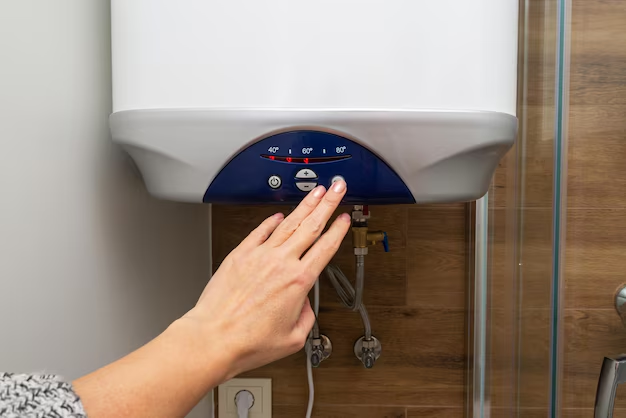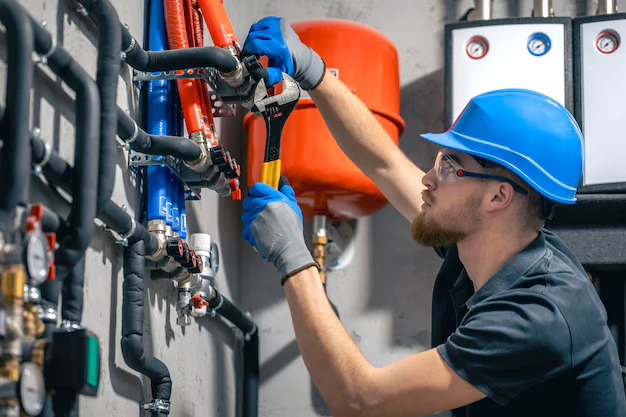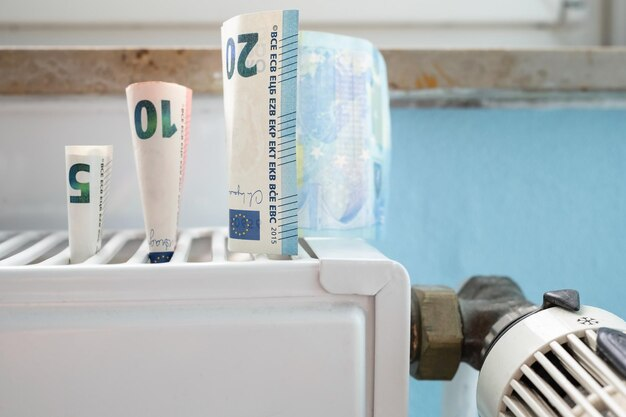Tank vs Tankless Water Heater: Which One Saves You More Money
- Vanshika Thareja

- Nov 3
- 10 min read

In the quest for a more efficient home, choosing the right water heater can make a significant difference in your energy bills. The decision between a traditional tank and a tankless water heater is one that many homeowners face. Both have their advantages and drawbacks, and understanding these can help you make an informed choice. Let's explore the intricacies of each type to determine which option could save you more money in the long run.
Understanding Water Heaters: Tank vs. Tankless

When it comes to water heaters, the debate often narrows down to two types: tank and tankless. Both serve the essential function of providing hot water for your home, but they do so in fundamentally different ways. Understanding these differences is crucial in making the right choice for your household's needs.
Traditional Tank Water Heaters
Traditional tank water heaters are more common in households and have been around for decades. These systems consist of a large tank that stores and heats a significant amount of water, typically ranging from 30 to 50 gallons. The water is heated continuously, regardless of whether you need it or not, which can lead to energy waste. This constant heating cycle can result in higher energy bills, especially if the tank is not well-insulated. However, the familiarity and straightforward design of tank water heaters make them a popular choice among homeowners. They are generally easier to repair and have lower upfront costs, which we'll explore further.
Tankless Water Heaters
Tankless water heaters, also known as on-demand water heaters, operate differently by heating water only when you need it. They don't store hot water in a tank; instead, they use high-powered burners to rapidly heat water as it passes through a heat exchanger. This means you get instant hot water without having to wait, and it eliminates the standby energy losses associated with traditional tank systems. The efficiency of tankless water heaters can lead to significant savings on energy bills over time. However, these systems often require a larger initial investment and may necessitate upgrades to your home's electrical or gas systems, which we'll discuss in detail.
Key Differences and Considerations
When deciding between tank and tankless water heaters, several key factors should be considered. These include the size of your household, your typical hot water usage, and the space available for installation. Traditional tank water heaters might be more suitable for larger households with high hot water demand, while tankless systems are ideal for smaller homes or those looking to maximize energy efficiency. Consider how often you use hot water and the peak times of use, as this can influence which system will provide the best savings and performance.
Initial Costs and Installation

The initial costs and installation requirements for water heaters are pivotal factors in your decision-making process. While the upfront price is often a significant consideration, it's essential to weigh this against potential long-term savings and performance benefits.
Cost of Traditional Tank Water Heaters
The initial cost of a traditional tank water heater is generally lower than that of a tankless model, making it an attractive option for those on a tight budget. You can expect to pay between $300 to $1,500 for the unit itself. Installation costs can range from $200 to $500, depending on the complexity of the installation and your home's existing plumbing setup. The simplicity of these systems often means less labor-intensive installation, which can further reduce costs. However, it's important to consider the potential for higher energy bills over time due to the constant heating cycle of these units.
Cost of Tankless Water Heaters
Tankless water heaters usually come with a higher price tag, ranging from $1,000 to $3,000. Installation can also be more expensive, ranging from $500 to $1,500. This is because tankless systems may require upgrades to your home's electrical or gas systems to accommodate the unit's power needs. Despite the higher upfront costs, many homeowners find that the energy savings over time can offset this initial investment. Additionally, some utility companies offer rebates or incentives for installing energy-efficient appliances like tankless water heaters, which can help mitigate the upfront expense.
Long-term Financial Considerations
When evaluating the financial impact of your water heater choice, it's essential to look beyond the initial costs. Consider the potential for energy savings, maintenance expenses, and the lifespan of the unit. Tankless water heaters typically have a longer lifespan and greater energy efficiency, which can lead to substantial savings over time. On the other hand, the lower initial cost of traditional tank water heaters may appeal to those with immediate budget constraints. Analyzing your household's specific needs and long-term financial goals will help you make the best decision.
Energy Efficiency and Savings

Energy efficiency is a critical aspect of choosing a water heater, as it directly impacts your utility bills and environmental footprint. Understanding how each type of water heater uses energy can help you determine which option will be more cost-effective in the long run.
Energy Use in Traditional Tank Water Heaters
Traditional water heaters continuously heat water, which can lead to significant energy loss, especially if the tank is not well-insulated. They tend to have a lower energy efficiency rating due to this constant heating cycle. In colder climates, the energy required to maintain the tank's temperature can be even higher, further increasing your energy bills. While improvements in insulation and technology have made modern tank water heaters more efficient than older models, they still can't match the efficiency of tankless systems. Regular maintenance, such as insulating the tank and checking the thermostat settings, can help mitigate some energy loss.
Energy Use in Tankless Water Heaters
Tankless water heaters are more energy-efficient because they only heat water as needed. According to the U.S. Department of Energy, a tankless water heater can be 24% to 34% more energy-efficient for homes that use 41 gallons or less of hot water daily. For homes that use a lot of hot water, the efficiency gain is around 8% to 14%. These savings can translate to lower utility bills and a reduced environmental impact. The precise energy savings will depend on your household's hot water usage patterns and the efficiency of the specific tankless model you choose. Additionally, tankless water heaters can be more effective in homes with simultaneous hot water demands, such as running a shower and washing machine at the same time.
Impact of Energy Efficiency on Savings
The energy efficiency of your water heater has a direct correlation with your potential savings. By reducing energy waste, you can lower your monthly utility bills and decrease your overall energy consumption. Tankless water heaters, with their on-demand heating capabilities, offer a significant advantage in this regard. However, it's essential to consider your household's hot water needs and usage patterns to determine the actual savings. In some cases, the increased efficiency of a tankless system may justify the higher initial investment, providing substantial long-term financial benefits.
Average Lifespan of Conventional Tank Water Heaters

The lifespan and maintenance requirements of your water heater are important factors to consider when evaluating the overall cost and convenience of each type. Both tank and tankless water heaters have different lifespans and maintenance needs, which can influence your decision.
Lifespan of Traditional Tank Water Heaters
Traditional tank water heaters typically last between 10 to 15 years. Regular maintenance, such as flushing the tank to remove sediment buildup, can help prolong its lifespan. Sediment buildup can reduce efficiency and lead to corrosion, which is why annual maintenance is recommended. Despite their shorter lifespan compared to tankless models, traditional water heaters are generally easier and less expensive to repair. However, as they age, the likelihood of leaks or other issues increases, potentially leading to costly repairs or replacement.
Lifespan of Tankless Water Heaters
Tankless water heaters generally have a longer lifespan, often lasting over 20 years. They require less maintenance, and since there's no tank to clean, the risk of sediment buildup is significantly reduced. The longevity of tankless systems can be attributed to their design, which minimizes the wear and tear associated with constantly heating a large volume of water. While the initial cost and installation can be higher, the extended lifespan and reduced maintenance needs can lead to overall savings. It's important to follow the manufacturer's recommendations for maintenance, such as descaling the unit periodically, to ensure optimal performance and longevity.
Maintenance Considerations and Costs
When evaluating the maintenance needs of your water heater, consider both the frequency and cost of necessary upkeep. Traditional tank water heaters may require more frequent maintenance, such as flushing the tank and replacing sacrificial anodes to prevent corrosion. Tankless water heaters, while requiring less frequent maintenance, may still need occasional descaling to remove mineral buildup, especially in areas with hard water. Budgeting for these maintenance costs and considering the convenience factor can help you make a more informed decision about which type of water heater is right for you.
Space and Installation Considerations

The space and installation requirements of water heaters can significantly impact your choice, especially if you have limited space or specific installation needs. Understanding these considerations will help you determine which option is more suitable for your home.
Space Requirements for Traditional Tank Water Heaters
Tank water heaters require a considerable amount of space due to the size of the tank. This can be a drawback if you have limited space in your home. They typically need a dedicated area, such as a utility room or basement, and must be installed in a location that allows for proper ventilation and easy access for maintenance. The space requirements of traditional tank water heaters can be a limiting factor in smaller homes or apartments, where every square foot counts. It's important to consider the available space in your home and any potential modifications needed to accommodate a tank water heater.
Space Requirements for Tankless Water Heaters
Tankless water heaters are compact and can be installed on walls, freeing up floor space. This makes them an excellent choice for smaller homes or apartments. Their compact size allows for more flexible installation options, such as mounting the unit in a closet, utility room, or even outdoors. This flexibility can be particularly beneficial in homes with limited space or unique architectural constraints. Additionally, tankless water heaters can be installed closer to the point of use, reducing the time it takes for hot water to reach faucets and minimizing heat loss through pipes.
Installation Flexibility and Considerations
When considering the installation of a water heater, it's important to evaluate the flexibility and potential challenges of each type. Traditional tank water heaters may require more space and specific locations for proper installation, while tankless systems offer greater flexibility. However, tankless water heaters may require modifications to your home's plumbing, electrical, or gas systems to support their operation. Consulting with a professional installer can help you assess the feasibility and potential costs of installation for each option, ensuring that you make the best choice for your home's layout and your budget.
Environmental Impact

The environmental impact of your water heater choice is an important consideration for eco-conscious homeowners. Understanding the ecological footprint of each type can help you make a more sustainable decision.
Environmental Considerations of Tank Water Heaters
Because traditional water heaters are less efficient, they tend to have a higher environmental impact. The constant heating of water results in higher energy consumption and increased greenhouse gas emissions. This inefficiency contributes to a larger carbon footprint and can have a negative impact on the environment. While newer models may offer improved efficiency compared to older units, they still fall short of the performance of tankless systems. For homeowners looking to reduce their environmental impact, the inefficiency of traditional tank water heaters is an important consideration.
Environmental Considerations of Tankless Water Heaters
Tankless water heaters, on the other hand, have a smaller carbon footprint. They use less energy and can significantly reduce your home's overall energy consumption. By heating water only when needed, tankless systems minimize energy waste and decrease greenhouse gas emissions. This efficiency makes them a more environmentally friendly option for homeowners looking to reduce their ecological impact. Additionally, some tankless models are designed to work with renewable energy sources, further enhancing their sustainability. Choosing a tankless water heater can be a step toward more sustainable living and a reduced environmental footprint.
Balancing Environmental Impact and Efficiency
When evaluating the environmental impact of your water heater choice, it's important to balance efficiency with sustainability. While tankless water heaters offer greater efficiency and a smaller carbon footprint, the higher initial costs and potential installation challenges should also be considered. Traditional tank water heaters, while less efficient, may be more accessible for some homeowners due to their lower upfront cost and simpler installation. Understanding your priorities and considering both the environmental and financial impacts of each option will help you make a more informed and sustainable decision.
The Bottom Line: Which One Saves More Money?

The decision between a tank and a tankless water heater ultimately depends on several factors, including your budget, space, and hot water usage. Each type has its advantages and drawbacks, and weighing these considerations will help you determine which option is more cost-effective for your household.
Initial Investment Considerations
If you're on a tight budget, a traditional tank water heater might be more cost-effective initially. The lower upfront cost and simpler installation process make them a practical choice for many homeowners. However, it's important to consider the potential for higher energy bills and maintenance costs over time. Evaluating your immediate financial situation and weighing it against long-term savings can help you make the best decision.
Long-term Savings and Energy Efficiency
If you're looking at long-term savings, a tankless water heater can provide significant energy savings over time, which might offset the higher upfront cost. The increased efficiency and longer lifespan of tankless systems can lead to substantial savings on energy bills and maintenance expenses. For energy-conscious homeowners, the tankless water heater is the clear winner. It reduces energy waste and lowers utility bills, making it an excellent investment for those looking to save money and reduce their environmental impact.
Making the Right Choice for Your Home
When choosing between a tank and a tankless water heater, consider your household's specific needs and usage patterns. Factors such as hot water demand, available space, and budget constraints will influence your decision. By carefully evaluating these considerations, you can select the water heater that best meets your needs and provides the greatest financial and environmental benefits.
Conclusion
Choosing between a tank and a tankless water heater involves weighing initial costs against long-term savings. While tankless water heaters require a higher upfront investment, their energy efficiency and longevity can lead to greater savings over time. Consider your household's specific needs and usage patterns to make the best decision for your home and wallet.
In the end, the right choice depends on your priorities—whether it's saving money upfront, maximizing energy efficiency, or reducing your environmental footprint. Whatever your decision, investing in the right water heater is a step toward more sustainable living and financial savings. By understanding the differences between tank and tankless water heaters, you can make an informed choice that aligns with your values and goals.

Comments